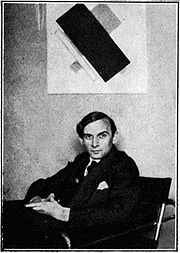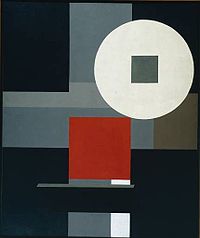
Friedrich Vordemberge-Gildewart
Encyclopedia

Osnabrück
Osnabrück is a city in Lower Saxony, Germany, some 80 km NNE of Dortmund, 45 km NE of Münster, and some 100 km due west of Hanover. It lies in a valley penned between the Wiehen Hills and the northern tip of the Teutoburg Forest...
, Germany
Germany
Germany , officially the Federal Republic of Germany , is a federal parliamentary republic in Europe. The country consists of 16 states while the capital and largest city is Berlin. Germany covers an area of 357,021 km2 and has a largely temperate seasonal climate...
– December 19, 1962, Ulm
Ulm
Ulm is a city in the federal German state of Baden-Württemberg, situated on the River Danube. The city, whose population is estimated at 120,000 , forms an urban district of its own and is the administrative seat of the Alb-Donau district. Ulm, founded around 850, is rich in history and...
) was a German
Germany
Germany , officially the Federal Republic of Germany , is a federal parliamentary republic in Europe. The country consists of 16 states while the capital and largest city is Berlin. Germany covers an area of 357,021 km2 and has a largely temperate seasonal climate...
Neo-plasticist
De Stijl
De Stijl , propagating the group's theories. Next to van Doesburg, the group's principal members were the painters Piet Mondrian , Vilmos Huszár , and Bart van der Leck , and the architects Gerrit Rietveld , Robert van 't Hoff , and J.J.P. Oud...
(De Stijl) painter. He was one of the first painters to work for his entire career within an abstract style.
Life
Friedrich Vordemberge-Gildewart was born in OsnabrückOsnabrück
Osnabrück is a city in Lower Saxony, Germany, some 80 km NNE of Dortmund, 45 km NE of Münster, and some 100 km due west of Hanover. It lies in a valley penned between the Wiehen Hills and the northern tip of the Teutoburg Forest...
, Germany and studied architecture, interior design and sculpture Hanover School of Art and the Technical College, Hanover
Hanover
Hanover or Hannover, on the river Leine, is the capital of the federal state of Lower Saxony , Germany and was once by personal union the family seat of the Hanoverian Kings of Great Britain, under their title as the dukes of Brunswick-Lüneburg...
. In 1924 he formed the abstract art group Gruppe K in Hanover with Hans Nitzschke and joined Der Sturm
Der Sturm
Der Sturm was a magazine covering the expressionism movement founded in Berlin in 1910 by Herwarth Walden. It ran weekly until monthly in 1914, and became a quarterly in 1924 until it ceased publication in 1932....
in Berlin
Berlin
Berlin is the capital city of Germany and is one of the 16 states of Germany. With a population of 3.45 million people, Berlin is Germany's largest city. It is the second most populous city proper and the seventh most populous urban area in the European Union...
. After meeting Theo Van Doesburg
Theo van Doesburg
Theo van Doesburg was a Dutch artist, practicing in painting, writing, poetry and architecture. He is best known as the founder and leader of De Stijl.-Biography:-Early life:...
, Kurt Schwitters
Kurt Schwitters
Kurt Hermann Eduard Karl Julius Schwitters was a German painter who was born in Hanover, Germany. Schwitters worked in several genres and media, including Dada, Constructivism, Surrealism, poetry, sound, painting, sculpture, graphic design, typography and what came to be known as...
and Hans Arp, he became a member of De Stijl
De Stijl
De Stijl , propagating the group's theories. Next to van Doesburg, the group's principal members were the painters Piet Mondrian , Vilmos Huszár , and Bart van der Leck , and the architects Gerrit Rietveld , Robert van 't Hoff , and J.J.P. Oud...
in 1925. Together with Kurt Schwitters
Kurt Schwitters
Kurt Hermann Eduard Karl Julius Schwitters was a German painter who was born in Hanover, Germany. Schwitters worked in several genres and media, including Dada, Constructivism, Surrealism, poetry, sound, painting, sculpture, graphic design, typography and what came to be known as...
and Carl Buchheister
Carl Buchheister
Carl Buchheister was a German constructivist artist noted for his multiple series of "model paintings" at Galerie Lambert Weyl, Paris. which he began in 1925.He was born in Hanover, Germany...
he formed the 'Abstrakten Hannover' group in 1927. He was a member of a number of other artistic groups including: the Cercle et Carré, 1930, Paris
Paris
Paris is the capital and largest city in France, situated on the river Seine, in northern France, at the heart of the Île-de-France region...
and was a founding member of Abstraction-Création
Abstraction-Création
Abstraction-Création was a loose association of artists formed in Paris in 1931 to counteract the influence of the Surrealist group led by André Breton....
(1931), also in Paris. In 1938 he was exhibited in the infamous Degenerate Art
Degenerate art
Degenerate art is the English translation of the German entartete Kunst, a term adopted by the Nazi regime in Germany to describe virtually all modern art. Such art was banned on the grounds that it was un-German or Jewish Bolshevist in nature, and those identified as degenerate artists were...
exhibition, most of his works were confiscated and he was forced to leave Germany for the Netherlands.
Work

- 1925, Composition No. 15 - 1925
- 1936, Composition No. 104 - 1936
- 1946, Composition No. 154, oil on canvas, 120 x 80 cm
- 1946, Untitled (C8), collageCollageA collage is a work of formal art, primarily in the visual arts, made from an assemblage of different forms, thus creating a new whole....
, paper and plastic on paper, 28.5 x 23.5 cm - c.1947, Untitled, collage on paper, 27.5 x 22.3 cm
- 1953, Composition No. 194, oil on canvas, 50 x 60 cm
- 1959/60, Composition No 212, oil on canvas, 105 x 80 cm

